From internal pipelines, drains are transported by external ...

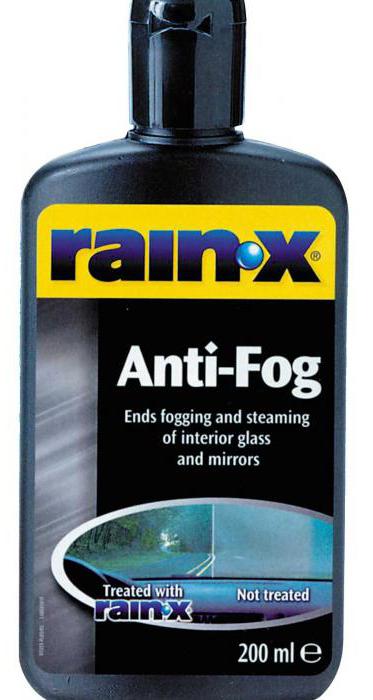
Each motorist was faced with an unpleasant and unexpected situation - fogging of windows in the car. This phenomenon introduces inconvenience and sharply increases the likelihood of accidents, so it is necessary to deal with it. Driver assistance is provided by special anti-fog glasses, which are described in detail in the article.
Glass fogging is the condensation that covers the inside of the window and degrades its performance. Drops of condensate scatter the incident light and act as a matte film - glass loses transparency (more than 40%), it erodes the contours of objects or makes them indistinguishable at all. A foggy car window dramatically reduces safety and can cause accidents.
Why does condensation form on the glass? The thing is in such a parameter as the dew point, or, which better reflects the essence - the temperature of the dew point of the gas (in our case, air). The dew point is an air temperature at which the water vapor contained in it condenses and falls out in the form of dew. It is important to note that the dew point can be observed both in a large volume of air, and only on any surface. In the first case, fog formation is observed, and in the second, condensation forms, including fogging of the windows.
The dew point directly depends on relative humidity and air temperature. Humidity in the car interior can reach 60% or more, and if the temperature inside the car is + 22 ° C, and in the street 15-16 ° C, then no condensation will drop out - for these parameters the dew point is about 14 ° C. However, over time, the air humidity in the cabin may increase (especially if there are several passengers), and the outside temperature may decrease (at least in the shade) - in this case the dew point is reached and conditions for condensation to form. And this process is very fast - in a matter of minutes.
The higher the air humidity and the greater the difference in air temperature in the cabin and on the street, the higher the likelihood of fogging the windows. That is why we most often encounter this phenomenon in the off-season, when air humidity due to rains and melting snow under the sun's rays (in spring) is very high, and the temperature varies widely. In winter, condensation falls into freezing windows, which are more difficult to deal with than fogging.
Anti-fog windows are designed to combat the unpleasant consequences of condensation.
Anti-fog windows is a group of special tools designed to combat fogging of glass and other surfaces. After treatment with these products, the windows resist the formation of small drops of condensate, as a result of which they do not fog up and retain their transparency.
You should immediately pay attention to an important fact: anti-fog windows do not prevent vapor condensation. Some manufacturers indicate that their products prevent the condensation of steam, but this is contrary to the laws of physics - condensation occurs in any case, however, anti-fogs minimize the negative consequences of this phenomenon.
All anti-fog windows have approximately the same operating principle - they create a hydrophobic coating on the surface of the window, which prevents the formation of small drops of water. Upon reaching the dew point, small water droplets formed on the surface of the glass “glide” over their repulsive coating, collide with each other and gradually merge into larger droplets visible to the naked eye. This forms either a thin water film or relatively large drops - in both cases the windows do not become dull and their transparency remains at an acceptable level.
As practice shows, when processing anti-fogging, the transparency of the windows when condensate drops is reduced by 7-9% (some funds have the worst result - 15-33%). So the use of anti-sweat is more than justified.
Anti-fogging is designed to prevent fogging of any transparent and reflective glass surfaces:
So that anti-fogging can be useful to motorists and motorcyclists, these funds provide good help in everyday life.
Today the market offers several types of anti-fogging agents that differ in form and method of application:
Regardless of type, all antifogs have essentially the same composition - usually it is an alcoholic solution of surface-active substances (surfactants). Alcohol degreases the surface, evenly distributes the active substance, and, quickly evaporating, prevents the product from draining through the window. And surfactants, respectively, form a hydrophobic film on glass. Some products also include filters that improve the transparency of the protective film, odorants, and protective polymers.
Modern products are made up of components that are safe for glass surfaces, plastics, polymer films (tinting), etc. Therefore, the majority of antifogs on the market have no contraindications for use.
The most popular antifogs in the form of sprays or aerosols, in general, their application is reduced to four steps:
In this case, you should follow a few simple rules:
The use of the foam spray differs only in that it is necessary to wait until the foam has completely dried, which usually requires more time than in the case of conventional sprays. Moreover, caution should be exercised here, since inaccurate application of foam can get on the dashboard. And when using a liquid, a napkin should be used - a certain amount of anti-sweat is applied to it (a lid with a level indicator is used for this), and the window is wiped.
The use of anti-fog cloth is also very simple:
In any case, before using anti-sweat, you should read the instructions for use. When used properly, the vehicle’s windows or bathroom mirror will be transparent regardless of conditions.
Other articles
December 28th
To perform many metal works, it is necessary to fix the workpieces for a short time. This is easily done using a special tool - a manual clamp with a lock. All about this tool, its types, design and characteristics, as well as its selection and use - read the article.
21 December
Monitoring the amount of air entering the cylinders is one of the foundations of the normal operation of a modern engine. To measure the amount of air, absolute pressure sensors are used - all about these devices, their types, design and operation, as well as the right choice and replacement, read in this article.
December 14th
Each vehicle has a light alarm system, which is switched on using a special switch. About what an alarm switch is, what types of it can be and how it is arranged, as well as the correct selection and replacement of this device, read the article.
December 7th
On many modern cars and other wheeled vehicles, wheels are mounted on a hub or brake drum using studs or embedded bolts and nuts. Everything about wheel nuts, their types, designs and applicability, as well as the correct selection and use of fasteners, is described in this article.
November 30th
When working with fittings, wire and other products in the form of rods, it becomes necessary to obtain segments of various lengths. Bar cutting is performed with a special tool - a bolt cutter or reinforcing scissors. All about this tool and its correct choice - read in this material.
November 23
To replace the wheels on trucks, tractors and other equipment, a special tool is often used - a mechanical wrench or torque amplifier. Read about this tool, its device, the principle of operation and basic characteristics, as well as about the choice and work with it.
November 16th
Reliable locking of doors, windows, sashes or covers is a guarantee of the safety of property in the house, garage, in the country and even in the mailbox. One of the most common means of locking is a padlock, the design and types of which, as well as the correct selection and application, read in this article.
Misting of windows in a car is a common occurrence, and in some regions it is widespread. It is necessary to prepare for it in advance, since it is quite difficult to eliminate the trouble with auxiliary means and at minimum intervals right on the spot. But there is a risk of losing control of the road and getting into trouble of a different kind. Protect yourself from such misfortunes in advance will help the anti-fog glass, which is available on the market in a variety of variations. The practice of using such tools is ambiguous, but if the right choice and observance of the operating rules are correct, a favorable result can be expected.
You should start the review with a standard tool, which many modern models already have in the basic configuration. Typically, this is a small device that works on the principle of a regular hair dryer. If such a device is not provided in the car, it can be purchased. In choosing it is worth paying attention to the temperature of the air flow, the speed of movement of the masses and power. Of course, the higher these indicators, the faster the device will save the salon from waterlogging. It is also worth paying attention to the material of manufacture of the device. Usually the anti-fog glass on automobile windows has a metal base, but for safety reasons, new devices are made of ceramics. Manufacturers provide them with automatic shutdown functions and overheat protection. As for placement, the device will not cause problems - it can be fixed on an adhesive tape or bracket, and the usual 12-volt cigarette lighter will act as a power source.

In general, this spray is suitable for use in conditions of risk of condensation. Users note marked changes in areas treated with this compound. Accumulation of water coatings is only occasionally observed. One of the main disadvantages of this tool can be called the lack of a special pump with a spray in some models. This causes some difficulties when applying a protective mass. More importantly, there is no visual distortion on the glass that this anti-fogger has processed. Reviews often emphasize the ability of such drugs to rid the surface of drops, but at the same time complain about the appearance of other problems. In this case, side effects are not detected.
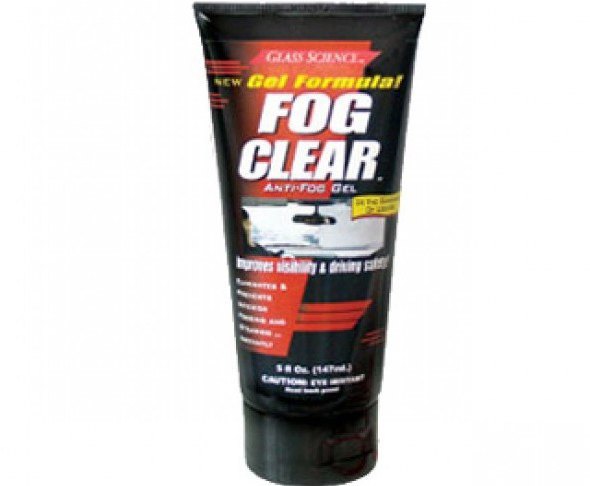
You can see that most of the car chemistry in the domestic market comes from China. It is clear that the quality of this product is seriously inferior to European counterparts, but there are pleasant exceptions. They are pleasant not only because of efficiency, but also because of affordable price. This applies to the simple Fog Clear tool from the manufacturer GlassScience. The official anti-fog test of this brand, which was carried out at -10 ° C with a humidity in the cabin of 94%, showed that the glass remained transparent for several hours. As for the users themselves, they also note the good performance of this product. The composition does not allow water vapor to condense, cleansing surfaces and from pollution. By the way, not only car owners, but also motorcyclists respond positively to this spray.
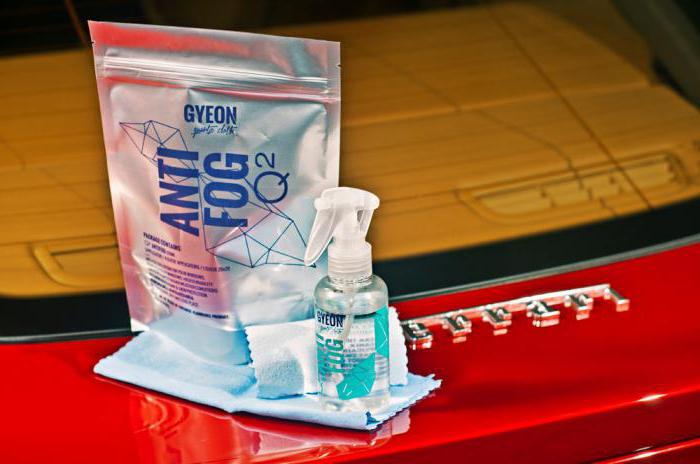
The company is positioning the drug as a highly effective coating that prevents condensation. It is important to consider that this spray refers to long-term remedies. According to users, the treatment retains protection against watery coating for two months. Also, the advantages possessed by the anti-fogging automobile Gyeon include ease of application, economy and an additional cleaning effect. For example, owners of heavy vehicles testify that only 20 ml is enough for a single treatment of their transport. The applied coating is enough for a long time, however, the drug itself is much more expensive than analogues.
First of all, the surface of the glass is cleaned. Depending on the composition and recommendations of the manufacturer, it may be necessary to use special tools that will prepare the basis for the further formation of a protective coating. The second stage involves the direct application of the spray. Usually the bulk is laid or sprayed, after which the user blurs it over the entire surface. To do this, the anti-fog glass is equipped with microfiber, which allows to optimally wash the composition without harming the surface. The operation should be performed in a place where ventilation is provided, and without direct exposure to sunlight on the work area.
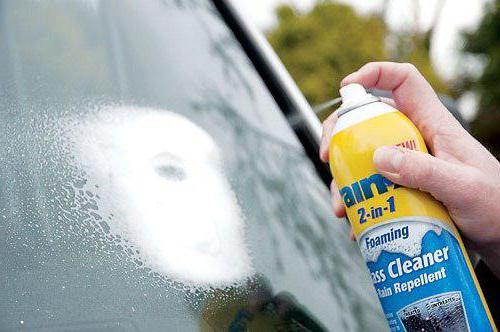
Most drugs of this type are positioned as universal remedies, which attracts more customers. Indeed, all drugs combine a protective function against condensation. But there are many factors that distinguish formulations from each other. Among them, one can single out application conditions, requirements for glass preparation, duration of effect, principle of operation, etc. Having determined the requirements for a particular machine, one can choose suitable anti-fogging agents for glasses. The tips of experienced motorists note that the quality composition does not necessarily stand in the lines of well-known brands such as Shell and Liqui Moly, so it is worth analyzing the characteristics of less popular products. As noted above, even Chinese inexpensive sprays are quite suitable for use in conditions of moderate threat of fogging.
One way or another, the formation of condensate on glass is not a problem today, and not only motorists are fighting it. And it is logical that many drivers do not spend money on car chemistry, but turn to proven and sometimes no less effective means. In particular, manufacturers of gas masks advise users of their products to lightly wipe the glass with a soapy composition. Divers also use this trick, treating masks and swimming goggles with similar solutions.
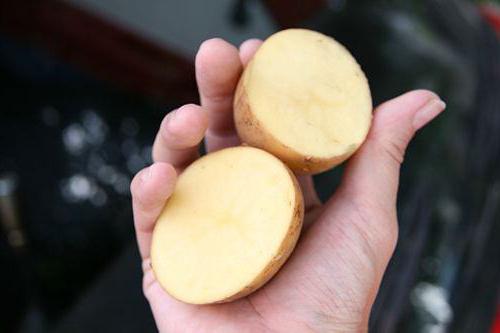
You can make glass anti-fogger with your own hands and with the help of the familiar vegetable - potatoes. It is enough to take a couple of shoots, cut them into two parts and wipe the surface of the glass with the released liquid. Next, grind the potato juice using the same microfiber or cloth. Of course, it is difficult to compare such techniques with professional means by the criterion of long-term effect, but practice shows that such protection is enough for several hours.
When at hand there are no means of protection against fogging of the glasses, it remains to use improvised equipment. The most affordable and acceptable in terms of effectiveness is a napkin. In general, for such purposes, car chemical manufacturers produce special microfiber products, but with a regular clean cloth you can provide a short-term result. To do this, moisten the cloth with water and, if possible, sprinkle it with a light cleanser from those at hand. It is best if it is a special anti-fogging car glass, but for a quick effect for 1-2 hours, any composition that forms the coating is enough. The main thing is that the resulting layer does not cause optical distortion. Next, you need to gently and without excessive pressure wipe the surface with a napkin until the glass becomes transparent.
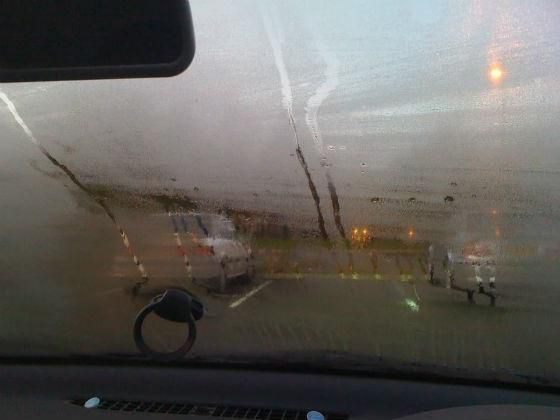
Water condensation inside the car is easily prevented by preventive measures that are available to any driver. It is enough to correctly dispose of the equipment involved in the creation of the local microclimate. First of all, it is necessary to turn on the furnace device and blowing the glasses. On the one hand, this will smooth the difference between temperature conditions in glass and air, and on the other, even the moisture that appears will be neutralized by the action of warm currents. This is an elementary trick that should be considered, not forgetting about other measures.
For example, if you pre-fabricate glass anti-fogger yourself with soap and potatoes and at the same time stock up with microfiber, then there will be no need to use specialized tools. However, this applies to single trips in conditions of suspiciously foggy weather. If regular movements in this mode are planned, then it is better to process the glass with a special preparation. Its purchase will cost money, but the proper level of security will remain.
FOG, FOG, FOG ...
Fog is considered to be the most dangerous weather phenomenon for driving a car. During it, not only the visibility greatly decreases, but various unpleasant optical phenomena occur, associated with the reflection and scattering of light on tiny droplets of water.
In almost the same way as fog, fogging of car windows is dangerous. The smallest drops of water, settling on the glass, begin to reflect the rays of light at such an angle that it becomes very difficult for the human eye to distinguish objects located on the other side of the fogged surface. But you can deal with this - and not only by turning on the stove and opening the windows. There is a special car cosmetics, the application of which on the glass prevents the formation of water droplets. The molecules of such agents have a high degree of hydrophilicity: they easily dissolve in drops of water and reduce their surface tension. As a result, the drops spread and form a layer of a continuous water film on the glass, which reflects light rays in the same way as a dry surface, and does not affect the transparency of the glass.
How we tested
Conducting comparative tests of anti-fogging was extremely simple. All we needed for this was a car, a steam generator and a cool autumn morning.
Having previously carefully processed the car glass with a cleaning compound, we divided it into two sectors using paper tape. We left one sector untouched, and on the second we applied anti-fog. Turning on the steam generator, we sent a stream of steam to the glass and after 10 seconds we recorded the result.
The composition is easily applied and polished on the surface of the glass; after drying it does not cause visual distortions.
After steam treatment in some parts of the sector covered by the Anti-Defog composition, an accumulation of water condensate was noted.
A tool that is convenient to use, but with an “uneven” nature of work.
The composition is easy to apply and polish on the surface of the glass. After drying, the drug layer does not cause visual distortions.
After steaming, both sectors of the glass were fogged up almost equally.
The drug does not work.
The composition of the drug is a pleasant "apple" fragrance is easily applied and polished. After drying, it does not cause visual distortions.
The tool showed a generally good result. But, as in the case of the LAVR preparation, although to a lesser extent, water condensate was visible in some areas of the sector treated with anti-fog.
Quite effective, thanks to fragrance and a pleasant rotation.
The drug is easily applied and polished on the surface of the glass; after drying it does not cause visual distortions. When spraying the "Anti-Fog", a sharp, without any signs of aromatic odorant smells good.
After processing the glass with steam, the sector covered with a layer of "Anti-fog" remained completely transparent, without the slightest trace of condensate.
A tool that can quickly and effectively eliminate fogging of glasses.
The composition is easy to apply and polish on the surface of the glass. After drying, it does not cause visual distortions. Included in the composition of the fragrance preparation slightly softens its pungent odor. The drug strangely enough demonstrated its performance: after processing glass, the process of moisture condensation on its surface significantly increased. After such a turn of events, one can only guess about the true purpose of the flannel napkin, sold as a set with anti-sweat.
A tool that stimulates the process of fogging glasses.
Before starting work, the cloth must be moistened with water. The glass processing process is accompanied by a slight foaming. After drying, the drug layer does not cause visual distortions.
After steaming, the glass sector, protected by the composition of the anti-sweat wipe, remained completely clean and transparent.
Convenient to use, devoid of a pungent or unpleasant odor means that effectively interferes with the process of fogging of glasses.
Due to the absence of a dehumidifier for the spray pump, it is difficult to apply its composition to the surface to be treated. After drying, the applied layer of the preparation does not cause visual distortions.
After steam treatment in a vector covered with a RAIN X layer, an accumulation of water condensate was observed in separate small sections of the glass.
It is a fully functional but inconvenient means of rotation.
The composition of the product is easy to apply and polish. After drying, it does not cause visual distortions. When spraying, its sharp enough smell is audible, without aromatic odorants.
LAVR has demonstrated a rather modest result. After steaming on the glass sector where “LAVR” was applied, separate “spots” of water condensate appeared, alternating with well-visible areas.
The preparation revealed an “uneven” nature of the work, due to which moisture condensation was clearly visible in some parts of the glass.
The composition is easy to apply and polish on the glass surface and after drying does not cause visual distortions. When spraying the drug, its sharp, odorless odor is well felt. After treating the glass with steam, no difference was found between the two equally misted sectors.
The drug does not work.
Before starting work, the napkin must be moistened with water. After drying, the drug layer does not cause visual distortions.
After steaming, the glass sector, on which the anti-sweat wipes were applied, remained completely clean and transparent.
Very convenient to use, devoid of a pungent or unpleasant odor means that effectively interferes with the process of fogging of glasses.
Spraying the drug is accompanied by a slight foaming, which somewhat slows down the processing of glass. After drying, the drug does not cause visual distortion. After steaming, the glass sector, covered with a layer of “Anti-Defog”, remained completely clear and clean, without a single trace of condensation of water on its surface.
The drug is able to effectively eliminate fogging of glasses.
Many, probably, faced such a widespread problem as fogging of glasses in the cold season. Misting, car windows cause serious inconvenience to drivers. In order to restore normal visibility, owners constantly have to spend time wiping the glass with all sorts of rags and auxiliary ... and sometimes even with their sleeves. However, sooner or later, each of them comes to the conclusion that these methods are primitive and ineffective.
Therefore, given the relevance of the topic, I propose to talk about methods of struggle, with the constant fogging of the windows of the car interior in the cold season.
Possible causes of fogging

The formation of condensation in the passenger compartment is often the cause of fogging of the windows, in other words, increased humidity, in the form of small particles (small drops of water) appears on the coldest elements of the passenger compartment, often windows. Moisture, in turn, is formed from human breathing, while the intensity of the fogging of glasses directly depends on the number of passengers in the car.
Humidity, which is formed in the passenger compartment, depends on moisture from the outside, this is especially felt on cloudy days. Also, one of the "centers" of moisture in the cabin in snowy or rainy weather is precisely the rugs, on which a sufficiently large amount of moisture is brought in by the shoes of passengers.
The third, among the main sources of moisture, is the stove. Yes Yes! This is not a typo and you heard it right, namely a stove, which is regularly turned on by drivers for heating in the cold season. The air intake of the stove is located in the upper part of the hood, near the plastic protection. Therefore, in case of accumulation of snow in this place, the humidity of the passenger compartment will increase, since when the engine heats up, the snow will melt.
Anti-fogging methods for car windows
As a prophylaxis in the fight against fogging, is the proper care of the inside of the car. What is meant, for example, during rain or snow, you should keep the car interior as clean as possible, and avoid that excess moisture accumulates there. It is enough to just shake or wipe the floor mats regularly, if there are no floor mats, do not be lazy and wipe the floor of the passenger compartment.
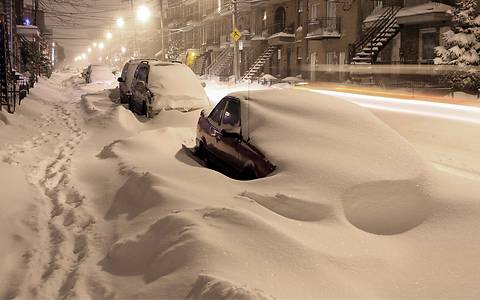
We noticed snow accumulation on the hood or its grill, shake it off, otherwise moisture will get inside the cabin when the stove is turned on. To dry the interior, turn on the air circulation, before clearing the glass from ice, in case of formation. Make sure that the glass cleaning fluid contains alcohol in its composition, it will not allow water to freeze on the windows.
Before you make a trip, it is necessary to warm up the interior of the car, this will prevent fogging. It is enough just to simultaneously turn on the heating of all the windows (front, rear and side). Remember that sudden changes in temperature can negatively affect the frozen windows of the car, so I recommend warming up the car windows gradually. To achieve maximum effectiveness in the fight against fogging of glasses, it is necessary that the circulation air filters are always dry and fresh, and the air conditioner is in good condition.

Perhaps the best way to combat the fogging of windows is with a car air conditioner, since it dries the air perfectly. If the car does not have air conditioning equipment, then you can cope with fogging the windows in the cabin with fresh air. To do this, just open the window, or turn on the air circulation when the stove is on.
For proper airflow operation, it is necessary to set the circulation lever to the left position, while directing the flaps to the most problem areas.
As one of the options, in the fight against fogging the windows of the car, is to change the duct in the trunk. To do this, you need to cut holes in the side trim of the trunk and install plastic grilles in them. Thus, you will increase the outflow of air, and air ventilation in the car will work more efficiently, while preventing fogging of the windows.
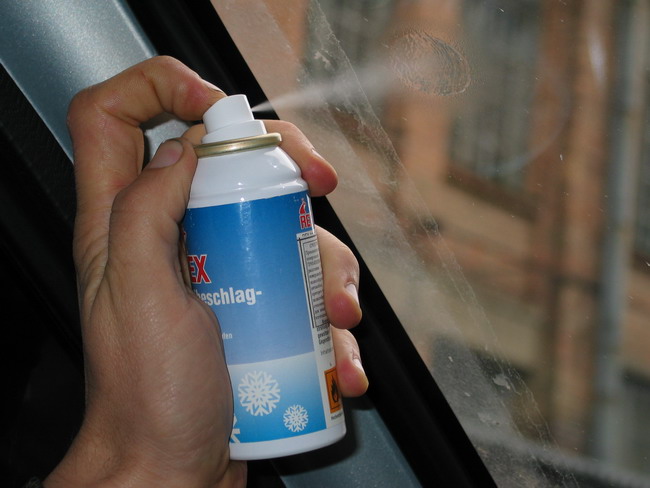
One of the effective ways in the fight against fogging glasses can be considered anti-fogging. They can prevent the formation of condensation and moisture. Anti-sweating in turn are divided into two groups. The first group includes funds, which are a special liquid that covers the glass with a kind of transparent water film. Such a film does not allow moisture to accumulate on the glass. The second group has similar properties, but unlike the first, they are also able to repel moisture.
The most expensive, but at the same time effective, are considered to be anti-fogging glasses, which are very close to mastic in texture. Covering the glass surface with such compositions, you can not worry about getting wet and fogging the glass. Moreover, they are distinguished by their durability; one treatment will be enough for several “rainy” trips.
Apply anti-fog only on dry and clean glass, and it should be thoroughly rubbed with a rag. It is important to understand that if the glass is already foggy, then it makes no sense to apply a preventive agent to it.
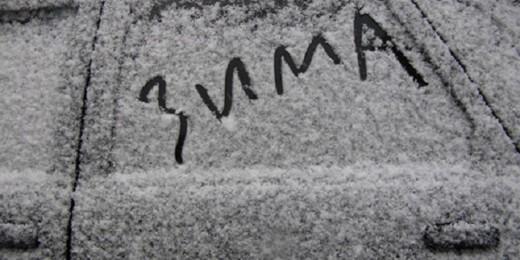
Tips such as: “turn on the heater as much as possible or open the window” at this moment do not work. While the heater heats the air in the cabin, and the windshield and side windows dry, it’s quite possible to go somewhere else (God forbid, of course).
The dew point is to blame for all this indecency. It's simple: air contains water in the form of steam. And the hotter the air, the more water it can contain - therefore, for example, in the tropics, clothes do not dry due to high humidity, and in Yakutia, on the contrary, the air is very dry in winter.
And when in the car warm air from the stove collides with cold glass, then water from the air falls into the glass in small drops. The temperature at which moisture begins to fall out of the air is called the “dew point”.
Strictly speaking, there are several parameters that affect the “dew points”: relative humidity, atmospheric pressure. There is a rather intricate formula by which this “point” is calculated. However, studying the physics of this process is not our topic.
It is worth adding that any passenger with each exhalation increases the humidity in the cabin. And alcohol in his body dramatically increases the moisture content in exhaled air. Which further exacerbates the sad picture ...
The first way is to really turn on the stove and blow the glasses. The temperature difference at the point of contact of air and glass will decrease, in addition, the flow of warm air will dry the moisture on the glass faster than it forms. This works, but in the event that the power of the stove and fan is sufficient (and this is not always the case, especially on Russian cars). In addition, it takes a long time to dry the windows, and you need to go right now ... You can somewhat enhance the effect by turning on the air conditioner (if any), which drains the air. But this, again, is a long time.
The second way is to open the window so that the air temperature inside and outside the car matches. Not an option, especially in rain and winter. The third way is to do something with glass. Actually, our conversation will be about this “third way”.
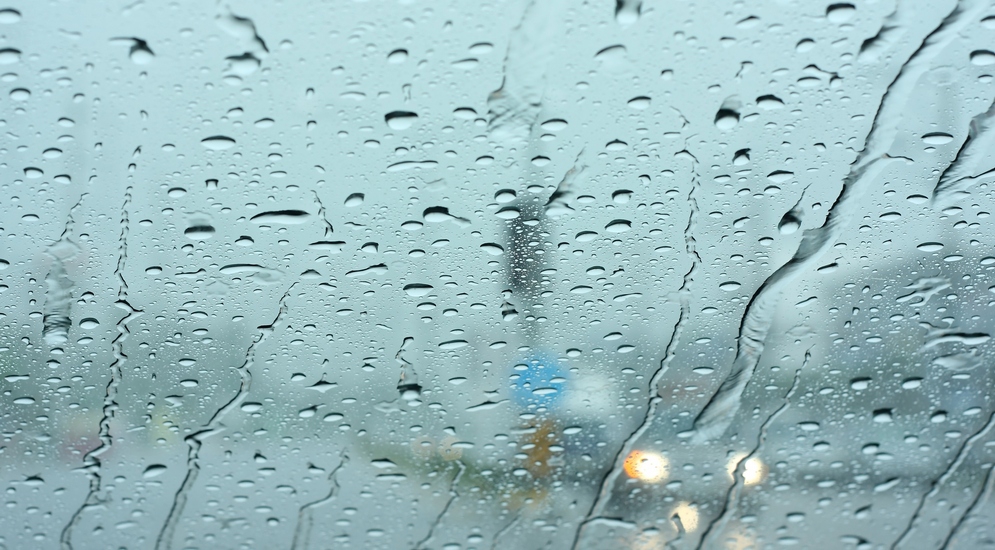
The easiest, most visual and uncomplicated way to get rid of fogging is to help a car heater (aka a stove). By and large, all Russian and Soviet cars need this. Perhaps, with the exception of the old ZAZovskys: in the “Cossacks” there was a gasoline stove, the power of which was enough in excess (we are not talking about comfort).
There are several models of electric anti-fogging on the market today. In principle, this is an ordinary hair dryer, with the help of which ladies style their hair and after a shower they dry the bathroom mirror (instead of just wiping it).
All of these anti-sweat very slightly differ from each other both in size (a kind of “box” of 20 x 15 x 10 cm. Naturally, plus or minus a few centimeters), and according to technical data.
The main operating characteristics are the air flow temperature from 400 C to 450 C, the maximum air flow speed is from 0.35 m / s to 0.45 m / s. Electric motor power - from 100 to 200 watts. The required working time is an average of 10 - 15 minutes.
For more expensive models, a ceramic heater instead of a metal one is used for safety, as well as built-in overheat protection and an auto power off function.
All of them are quite easy to install on brackets or adhesive tape, powered by a “cigarette lighter” - 12 volts. Some models can be powered by a 12-24 volt source. Some have two modes: “hot” and “cold”.
For example, the relatively inexpensive anti-fog Light Point Technology has a metal heating element. And in the more expensive and “sophisticated” Valad Electric Heating, in addition to overheating protection for the ceramic heater, there is also built-in high voltage protection. A brushless motor is also used, which reduces the noise level compared to even less powerful counterparts and extends the life of the engine.
It probably makes no sense to list the models of such electric anti-foggers - there are too many of them, and they are made in the same country. However, it is worth noting that in some cases the “device” is useful, and sometimes irreplaceable, especially in Russian cars. Such anti-sweat are inexpensive, “long-playing” and, in general, reliable.
... By the way, there is another, exotic, type of electric anti-fog - passive. These are parallel conductive threads glued to the glass inside the cabin. Today, such anti-foggers are standard equipment: on almost all automobiles, these threads are built into the glass even at the stage of its molding. In addition, it is not recommended to install passive anti-fogging agents on windshields: it reduces the visibility and concentration of the driver’s attention. Therefore, it is difficult to find such a system separately, it is dreary to install, and its performance is low. In general, this is a “device” for special vehicles operating in the difficult conditions of the North ...

Consider several products on the market:
Fog Clear Spray
Made by the Chinese company GlassScience. The composition is not specified.
According to the manufacturers, the test tests of the drug were carried out at -10 ° C outside the car, humidity in the cabin 94%, and temperature in the cabin + 24 ° C. For several hours, the glass remained transparent.
Liqui Moly Anti-Defog Aerosol.
Produced by the famous German concern Liqui Moly GmbH. The composition is not specified.
The drug does not allow water vapor to condense on the glass, cleans of impurities and has a long-lasting effect. It can be used on ordinary glasses, transparent plastic and visors of motorcycle helmets. Reviews: "It works unevenly, leaving spots of fog in some areas."
Aerosol "VELV Anti-sweat"
Produced by CJSC SZK VELV. Composition: alcohols, PVP / VA copolymer, flavor, hydrocarbon propellant.
The drug is intended to prevent fogging inside the cabin windows, while improving visibility and increasing traffic safety. “Anti-fog” can be used to prevent fogging of shop windows, window panes and mirrors, and has a long-lasting effect.
However, by analyzing the responses, we can conclude that it works, so to speak, “not quite efficiently”.
Shell Shell Antifog
Pump bottle made to order by Shell
Composition: isopropanol, anionic surfactant (less than 5%), flavor
“Anti-fog” effectively removes moisture from glass surfaces. Prevents the appearance of fumes on the windows and mirrors of the car. According to reviews, the tool is effective. And without a pungent odor.
"Anti-fog"
Bottle with a pump from the company Tribotechnology Laboratory (Russia).
Composition:detergent component, moisture-absorbing polymer, isopropanol, water, flavor. "Anti-fog" prevents the formation of droplets on the surface of the glass. The product is neutral to rubber, plastics, paintwork and chrome surfaces. Reviews are very good: the drug is effective.
Bottle with pomp + K&T Anti-sweat wipes
Khimpromproekt CJSC by order of Leather and Technology LLC.
Composition:polymers, surfactants, stabilizer, isopropanol. According to reviews, after processing the glass, the process of moisture condensation on its surface did not stop, but significantly increased ...
ASTROCHEM
Bottle with a pump LLC NPP ASTROCHEM LLC (Russia). The composition is not specified.
It has a washing effect, at the same time removes condensation from the windows inside the car. The film formed by it prevents further fogging of the glasses. According to reviews, the drug is able to effectively eliminate fogging of glasses.
Actually, the description of such drugs could be continued for a very long time - the market offers many options, both Russian-made and foreign.
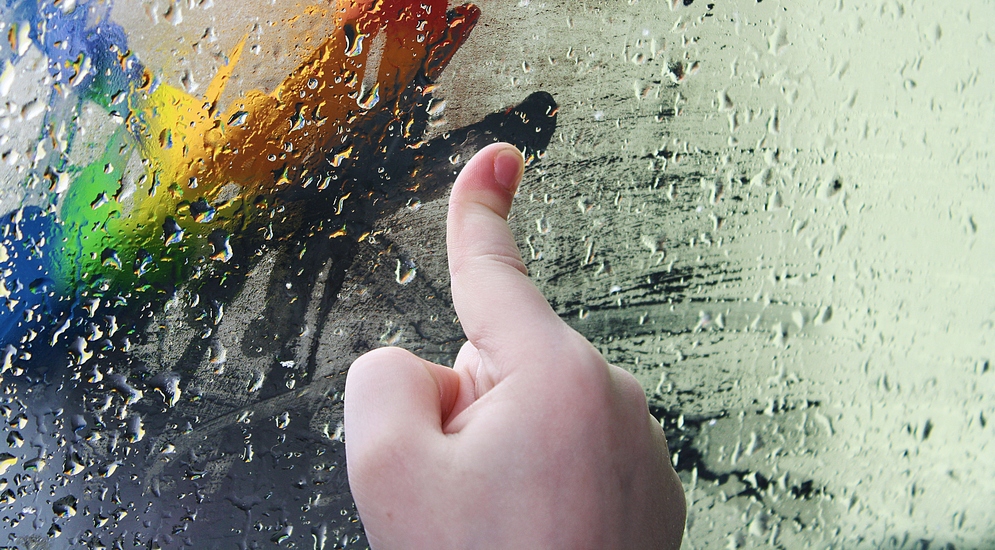
Firstly, beautiful (or ugly) packaging, convenience (or inconvenience of use) does not guarantee the quality of the product.
Secondly, the quality of processing, and hence the effectiveness of the drug, depends on the thoroughness of the preparation of the glass. If it is said in the instruction: "... on a clean, dry surface ...", it means that the windshield must really be thoroughly washed and dried. Desirable - with alcohol: due to the high hydrophilicity, ethyl alcohol will remove moisture residues. This is important because surfactant molecules, having a complex structure, have both hydrophilic and hydrophobic properties. Simply put, it is important that the hydrophilic “side” —that transforms small droplets into a thin film of water — is on the surface facing the saloon.
Thirdly, it is worth choosing an anti-fogmer not by brand, country of production or price - but choosing the one that works best on your machine. And the responses about this or that drug that can be read on the Internet are just the opinion of one person on a specific anti-fog on a particular car. It is possible that your drug will work perfectly.
In general, as Peter I said: “Do not adhere to the Charter, like a blind wall, because the rules are written in it, but there are no times and cases” ...
And fourthly. Water on the windshield outside and inside the passenger compartment are two different cases. Therefore, do not look for a "universal" drug. Outside, a hydrophobic coating is required for the glass, which causes water to drip from the surface. And inside the cabin - on the contrary, hydrophilic, which helps to form a thin film of water, which does not distort the light flux.
Glass fogging is an effect familiar not only to car owners. Therefore, methods for dealing with it have long been known. Manufacturers of gas masks, for example, recommend applying “netting” with soap to the glasses. But scuba diving enthusiasts know that to prevent fogging, they need to spit on the glass from the inside, and then rinse in water.
Everything, in general, is correct. But the windshield is big - and spit it for a long time. And the film formed by soap is applied for a long time, it is difficult to polish. And too little time is kept. Therefore, we would not recommend folk methods.